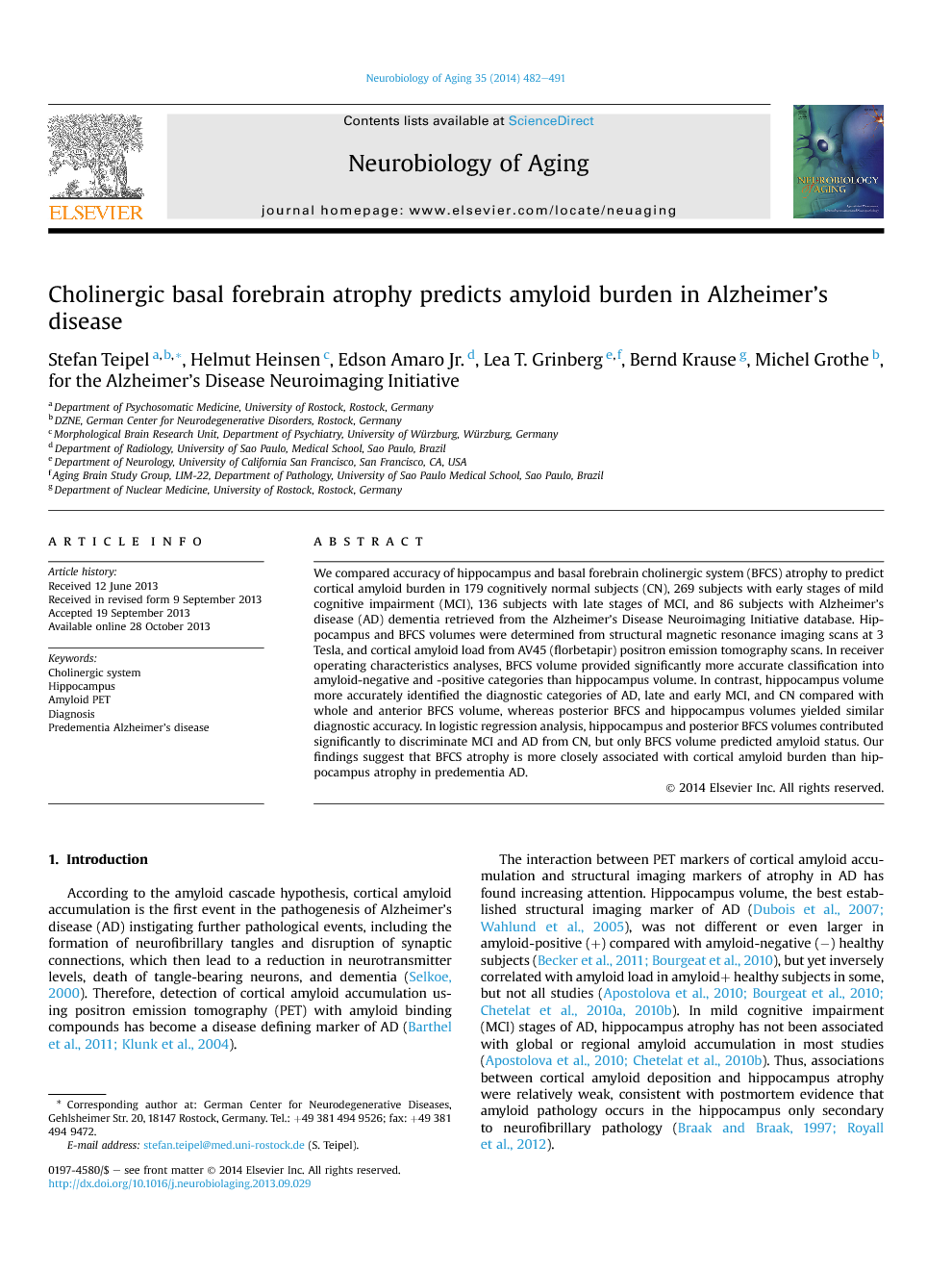We compared accuracy of hippocampus and basal forebrain cholinergic system (BFCS) atrophy to predict cortical amyloid burden in 179 cognitively normal subjects (CN), 269 subjects with early stages of mild cognitive impairment (MCI), 136 subjects with late stages of MCI, and 86 subjects with Alzheimer's disease (AD) dementia retrieved from the Alzheimer's Disease Neuroimaging Initiative database. Hippocampus and BFCS volumes were determined from structural magnetic resonance imaging scans at 3 Tesla, and cortical amyloid load from AV45 (florbetapir) positron emission tomography scans. In receiver operating characteristics analyses, BFCS volume provided significantly more accurate classification into amyloid-negative and -positive categories than hippocampus volume. In contrast, hippocampus volume more accurately identified the diagnostic categories of AD, late and early MCI, and CN compared with whole and anterior BFCS volume, whereas posterior BFCS and hippocampus volumes yielded similar diagnostic accuracy. In logistic regression analysis, hippocampus and posterior BFCS volumes contributed significantly to discriminate MCI and AD from CN, but only BFCS volume predicted amyloid status. Our findings suggest that BFCS atrophy is more closely associated with cortical amyloid burden than hippocampus atrophy in predementia AD.
According to the amyloid cascade hypothesis, cortical amyloid accumulation is the first event in the pathogenesis of Alzheimer's disease (AD) instigating further pathological events, including the formation of neurofibrillary tangles and disruption of synaptic connections, which then lead to a reduction in neurotransmitter levels, death of tangle-bearing neurons, and dementia (Selkoe, 2000). Therefore, detection of cortical amyloid accumulation using positron emission tomography (PET) with amyloid binding compounds has become a disease defining marker of AD (Barthel et al., 2011 and Klunk et al., 2004).
The interaction between PET markers of cortical amyloid accumulation and structural imaging markers of atrophy in AD has found increasing attention. Hippocampus volume, the best established structural imaging marker of AD (Dubois et al., 2007 and Wahlund et al., 2005), was not different or even larger in amyloid-positive (+) compared with amyloid-negative (−) healthy subjects (Becker et al., 2011 and Bourgeat et al., 2010), but yet inversely correlated with amyloid load in amyloid+ healthy subjects in some, but not all studies (Apostolova et al., 2010, Bourgeat et al., 2010, Chetelat et al., 2010a and Chetelat et al., 2010b). In mild cognitive impairment (MCI) stages of AD, hippocampus atrophy has not been associated with global or regional amyloid accumulation in most studies (Apostolova et al., 2010 and Chetelat et al., 2010b). Thus, associations between cortical amyloid deposition and hippocampus atrophy were relatively weak, consistent with postmortem evidence that amyloid pathology occurs in the hippocampus only secondary to neurofibrillary pathology (Braak and Braak, 1997 and Royall et al., 2012).
Besides amyloid accumulation, cholinergic degeneration is regarded as a key event in AD pathogenesis (Mesulam, 2004). Degeneration of basal forebrain cholinergic nuclei occurs in early and predementia stages of AD (Mann et al., 1984, Perry et al., 1978, Sassin et al., 2000 and Whitehouse et al., 1981). Animal models and postmortem brain studies provide evidence for a 2-way interaction between cholinergic transmission and amyloid accumulation (Schliebs and Arendt, 2006), with a specific vulnerability of cholinergic basal forebrain neurons to amyloid toxicity (Boncristiano et al., 2002) and increased amyloid formation with decline of cholinergic transmission (Beach, 2008). Volumetric measurement of cholinergic nuclei in the basal forebrain has become available (Grothe et al., 2010, Grothe et al., 2012 and Teipel et al., 2005) using in vivo structural magnetic resonance imaging (MRI) and masks of the basal forebrain cholinergic nuclei derived from postmortem MRI and histology (Heinsen et al., 2006).
Other than amyloid end points, changes in hippocampus volume were consistently found to be associated with episodic memory impairment (Grothe et al., 2010, Mortimer et al., 2004, Reitz et al., 2009 and Teipel et al., 2010), the defining clinical criterion for MCI. Accordingly, hippocampus volume was superior to cortical amyloid load in discriminating amnestic MCI subjects from healthy control subjects in a previous study (Jack et al., 2008). So far, BFCS volume has been little studied for diagnosis of MCI, reaching an accuracy below that of hippocampus volume in one previous study (Grothe et al., 2012).
Based on these findings, our primary hypothesis was that BFCS volume would be more sensitive to cortical amyloid accumulation than hippocampus volume in cognitively healthy elderly and MCI subjects. Our secondary hypothesis was that hippocampus volume would be more sensitive than BFCS volume to predict a diagnosis of MCI. We used data from 670 subjects retrieved from the Alzheimer's Disease Neuroimaging Initiative (ADNI) database (adni.loni.ucla.edu) comprised of subjects with AD dementia, early and late stages of MCI, and cognitively healthy elderly subjects. Based on this sample, we determined the accuracy of BFCS and hippocampus volumes to predict PET-based classification into amyloid+ or amyloid− subgroups and to differentiate MCI subjects from cognitively healthy control subjects irrespective of amyloid status.


